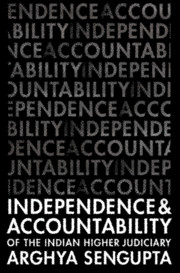Book contents
- Frontmatter
- Dedication
- Contents
- Acknowledgements
- List of Abbreviations
- List of Cases
- List of Statutes
- 1 Introduction
- PART I THE INDIAN EXPERIENCE
- 2 Pre-Tenure Questions: Appointments to the Higher Judiciary
- 3 In-Tenure Questions: Mechanisms for Judicial Discipline
- 4 Post-Tenure Questions: Post-Retirement Appointments of Judges by Government
- PART II A CONCEPTUAL ANALYSIS
- PART III TYING THE STRANDS
- Epilogue: The Moment the Judiciary Came Out
- Appendix Post-Retirement Employment of Judges in Government-Appointed Positions
- Bibliography
- Index
3 - In-Tenure Questions: Mechanisms for Judicial Discipline
from PART I - THE INDIAN EXPERIENCE
Published online by Cambridge University Press: 26 April 2019
- Frontmatter
- Dedication
- Contents
- Acknowledgements
- List of Abbreviations
- List of Cases
- List of Statutes
- 1 Introduction
- PART I THE INDIAN EXPERIENCE
- 2 Pre-Tenure Questions: Appointments to the Higher Judiciary
- 3 In-Tenure Questions: Mechanisms for Judicial Discipline
- 4 Post-Tenure Questions: Post-Retirement Appointments of Judges by Government
- PART II A CONCEPTUAL ANALYSIS
- PART III TYING THE STRANDS
- Epilogue: The Moment the Judiciary Came Out
- Appendix Post-Retirement Employment of Judges in Government-Appointed Positions
- Bibliography
- Index
Summary
Disciplining judges of the higher judiciary in India, the guardians of the country's Constitution, has always been an inconvenient exercise. As occupants of high judicial offices, charged with upholding the majesty of the law and the ends of justice, judges benefit from a public perception of infallibility, an other-worldly sense of virtue. Contributing significantly to this perception are the personnel who have held high judicial offices in India—men and women of supreme learning and erudition who have brought dignity to their offices by virtue of occupying them. But as is inevitable with any human institution, cut through the wondrous accoutrements and over time its bare mortality begins to show. Judges, like other fallible human beings, require disciplining, for personal misconduct, corruption, bias and poor quality of work, among other things. At the same time, such disciplinary measures must be taken carefully, neither seeking to influence the decision-making independence of the judge or the judicial institution nor affecting the dignity and high status of the judicial office in public perception. Achieving such a balance is a difficult task, one that has caused much inconvenience to both the government of the day and the chief justices at the time, who have been vested with this responsibility.
When action is taken against an allegedly errant judge, generally it assumes one of three forms or a combination of them: first, an in-house punitive procedure conducted internally under the supervision of the chief justice of India usually on the receipt of a complaint; second, a transfer of a High Court judge from one High Court to another for actual or purported misconduct; third, if the matter is deemed serious enough to warrant removal of a judge, impeachment by parliament in accordance with Art. 124(4) for judges of the Supreme Court of India and Art. 124(4) read with Art. 218 for judges of the High Courts. This chapter will analyse the second and third of the aforesaid mechanisms for disciplinary action to assess whether on an overall analysis they are efficient and practically workable. Such an analysis will highlight the questionable legal basis for the operation of judicial transfers and the insufficiency of impeachment as a disciplinary mechanism besides demonstrating other strengths and weaknesses of extant mechanisms.
- Type
- Chapter
- Information
- Publisher: Cambridge University PressPrint publication year: 2019
- 1
- Cited by



